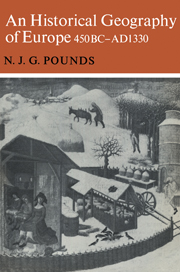4 - Europe in the age of Charlemagne
Published online by Cambridge University Press: 05 June 2012
Summary
The early years of the ninth century were, compared with those which preceded and followed, a period of relative peace. In the east, the Arab attack on Constantinople had failed, and, though the Middle East was finally lost, Asia Minor had been retained for the Eastern Empire. So also had the imperial footholds in southern Italy and around the shores of the Adriatic Sea. The First Bulgarian Empire straddled the Balkan peninsula. Its rulers at intervals threatened the Byzantine Empire, but they were imitators of the emperors, rather than barbarian invaders intent only on destruction.
The Western Empire had disintegrated more completely than the Eastern. Its line of emperors had ended in 476, and the splendour of the imperial court and the unity of its administrative system were but memories. But on Christmas Day, in the year 800, Charles, son of Pippin the Short and King of the Franks, was crowned emperor by Pope Leo III. The meaning of this act continues to be disputed. But to most people who knew of it, it symbolised the power and continuity of imperial rule; it gave hopes of a new period of peace, prosperity and internal harmony, and it represented Charles as picking up the reins of power that had fallen from the ineffective hands of Romulus Augustulus, and establishing himself as the new Constantine.
Charlemagne, as he has become known to posterity, was indeed fortunate. The Moslem threat to western Europe had receded two generations earlier.
- Type
- Chapter
- Information
- An Historical Geography of Europe 450 B.C.–A.D. 1330 , pp. 170 - 226Publisher: Cambridge University PressPrint publication year: 1973



